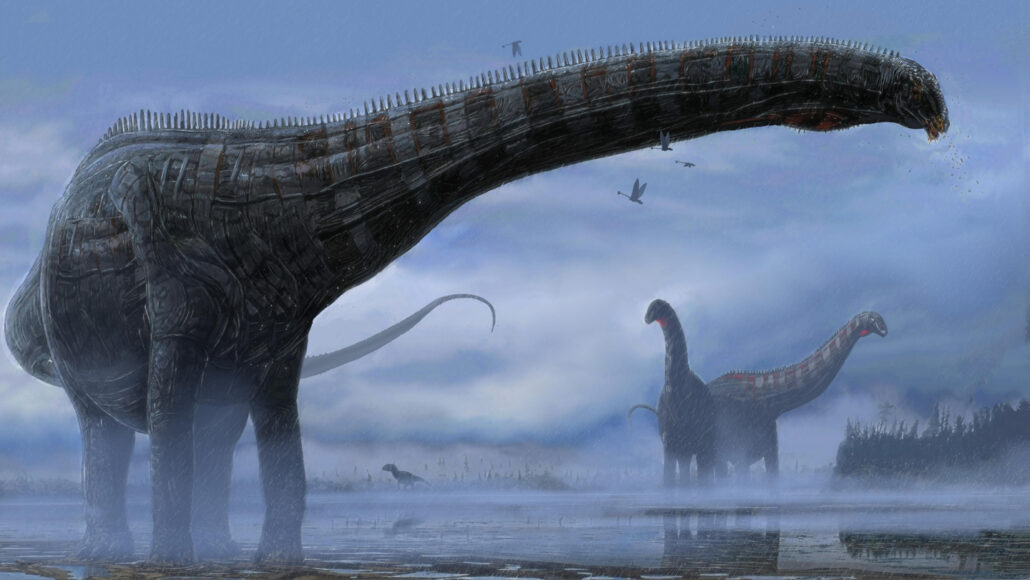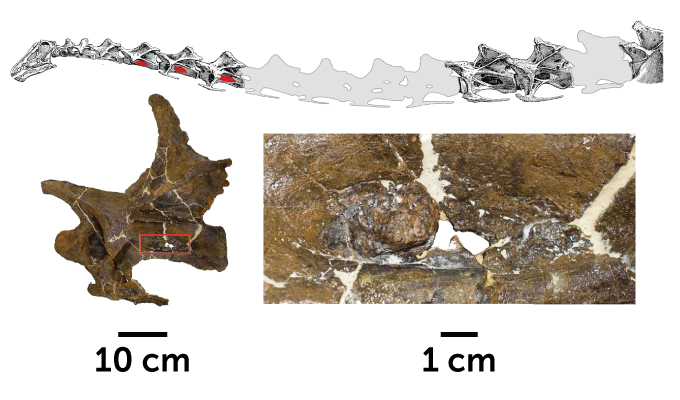Dinos may have had the sniffles 150 million years ago
A lung infection likely led to lesions seen in the fossil of a sauropod named Dolly

A long-lasting respiratory infection may have led to bone lesions that showed up in the remains of a 150-million-year-old sauropod dinosaur (like the ones in this illustration).
D.C. Woodruff et al/Scientific Reports 2022, © Corbin Rainbolt
By Sid Perkins
Even dinosaurs got sick. Scientists had long known that these ancient creatures could suffer a variety of diseases. But proving that by looking at fossilized bones was never easy. Now, researchers have unearthed evidence of what appears to be the oldest known respiratory infection in a dino. It shows up as lesions — tissue abnormalities — in the fossil vertebrae of “Dolly.” This teenaged dino was a bulky, long-necked sauropod. Some 150 million years ago, she plodded across what is now southwestern Montana.
Dolly became sick at least 50 million years earlier than a dino with a suspected case of pneumonia. That titanosaur in Brazil had been the earliest case of an apparent respiratory infection. Even that was long, long before a T. rex appears to have become infected with a parasite and died.
The long-necked Dolly was likely a close relative of Diplodocus. At the time of her death, she was some 18 meters (59 feet) long. Cary Woodruff is a vertebrate paleontologist with the Great Plains Dinosaur Museum in Malta, Mont. He was part of a team that described Dolly’s lesions on February 10 in Scientific Reports.
The researchers analyzed Dolly’s skull and the first seven vertebrae in her neck. These bones would have contained air sacs that connected to her lungs and other parts of her respiratory system. The bones of many modern-day dinosaurs — we call them birds — have similar features.
Dolly’s fifth, sixth and seventh vertebrae had lesions where the air sacs would have intruded into the bone. These oddly shaped and textured bumps stuck out from the bone by as much as 1 centimeter (less than a half-inch), says Woodruff.

There were lots of these lesions. Dolly having so many and in similar spots suggests they’re not bone tumors, Woodruff says. In fact, bone tumors are rather uncommon in birds. His team finds it more likely that the lesions formed when a lung infection spread to her neck’s air sacs.
Those bone bumps would not have been obvious to an ancient observer. But Dolly probably looked ill, the scientists say. She likely had a fever, cough, labored breathing — even a runny nose.
It’s not clear what caused her illness. It could have been bacteria, some virus or fungi. It’s not even known whether the sickness killed her. But the fungus Aspergillus can trigger respiratory disease in many birds and reptiles today, Woodruff’s team points out. And some of those infections will go on to affect bone tissues.
For an infection in the air sacs of the neck to cause bony lesions, “you’re looking at a chronic condition,” says Cynthia Faux. She’s a veterinarian at the University of Arizona in Tucson. She did not take part in the new research, but has studied vertebrate paleontology.
Even arthritis and gout could afflict dinos and other ancient creatures. And while Dolly’s lung infection seems to be the oldest in a dinosaur, it’s far from a record. In 2018, researchers described a tuberculosis-like infection in a marine reptile. It lived some 245 million years ago.







